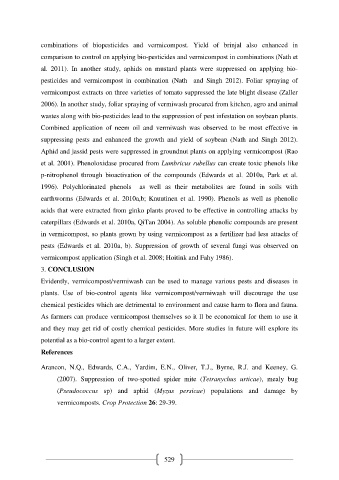Page 539 - e-Book
P. 539
combinations of biopesticides and vermicompost. Yield of brinjal also enhanced in
comparison to control on applying bio-pesticides and vermicompost in combinations (Nath et
al. 2011). In another study, aphids on mustard plants were suppressed on applying bio-
pesticides and vermicompost in combination (Nath and Singh 2012). Foliar spraying of
vermicompost extracts on three varieties of tomato suppressed the late blight disease (Zaller
2006). In another study, foliar spraying of vermiwash procured from kitchen, agro and animal
wastes along with bio-pesticides lead to the suppression of pest infestation on soybean plants.
Combined application of neem oil and vermiwash was observed to be most effective in
suppressing pests and enhanced the growth and yield of soybean (Nath and Singh 2012).
Aphid and jassid pests were suppressed in groundnut plants on applying vermicompost (Rao
et al. 2001). Phenoloxidase procured from Lumbricus rubellus can create toxic phenols like
p-nitrophenol through bioactivation of the compounds (Edwards et al. 2010a, Park et al.
1996). Polychlorinated phenols as well as their metabolites are found in soils with
earthworms (Edwards et al. 2010a,b; Knuutinen et al. 1990). Phenols as well as phenolic
acids that were extracted from ginko plants proved to be effective in controlling attacks by
caterpillars (Edwards et al. 2010a, QiTan 2004). As soluble phenolic compounds are present
in vermicompost, so plants grown by using vermicompost as a fertilizer had less attacks of
pests (Edwards et al. 2010a, b). Suppression of growth of several fungi was observed on
vermicompost application (Singh et al. 2008; Hoitink and Fahy 1986).
3. CONCLUSION
Evidently, vermicompost/vermiwash can be used to manage various pests and diseases in
plants. Use of bio-control agents like vermicompost/vermiwash will discourage the use
chemical pesticides which are detrimental to environment and cause harm to flora and fauna.
As farmers can produce vermicompost themselves so it ll be economical for them to use it
and they may get rid of costly chemical pesticides. More studies in future will explore its
potential as a bio-control agent to a larger extent.
References
Arancon, N.Q., Edwards, C.A., Yardim, E.N., Oliver, T.J., Byrne, R.J. and Keeney, G.
(2007). Suppression of two-spotted spider mite (Tetranychus urticae), mealy bug
(Pseudococcus sp) and aphid (Myzus persicae) populations and damage by
vermicomposts. Crop Protection 26: 29-39.
529

